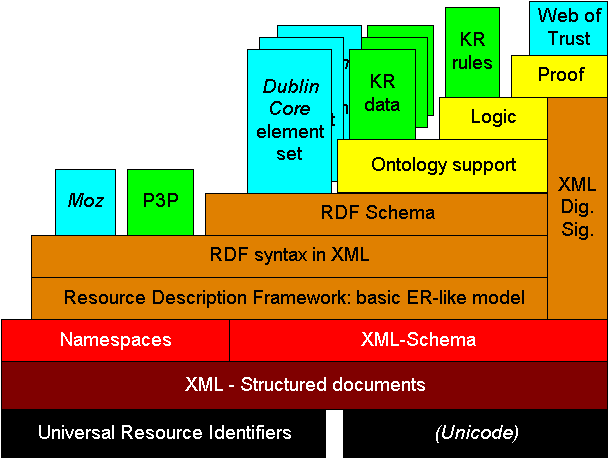Semantic Web Workshop - ISNID
Inferential Semantics for Networked Image Data:
Supporting the Derivation and Management of Semantic Attributes for Web-Based Multimedia Content
Harold Boley (DFKI) and Jos De Roo (AGFA)
Background (AGFA and DFKI)
- At Agfa, the declarative Eve and
Euler systems have
been developed for capturing and transforming networked image data.
- The Euler work has incorporated image annotations on the basis
of the W3C's RDF standard.
- At DFKI, the inference rule system
RFML has been developed,
which can be applied to annotations for deriving new semantic
attributes.
- The joint RuleML
Initiative has started to unify the various markups for XML and
RDF inference rules.
Building the future (taken from Tim Berners-Lee)

Problem
- In practice, there is a lot of simple rules that can operate
on a combination of extracted image features (obtained via image
analysis) and additional image-related data.
- The implicit meaning in image data can thus be made explicit.
- We study the issue of how to infer (only) meaningful facts from
networked image data.
- In the non-distributed case, the semantics of some centralized
image data can be regarded model-theoretically, as the set of
facts whose deduction is sanctioned by the given rules.
- For example, rules can infer the transitive closure of a centralized
'connected' attribute. In the distributed case, we usually have an
open network of image data, for which no model-theoretic semantics
exists.
- In the example, the transitive closure of a distributed
multi-sensor-derived 'connected' attribute may never form a single
stable set.
Proposal
- We thus propose tailored, "least power" mechanisms for inferencing
with attributes specific for images such as topology, gemometry,
texture and color.
- These mechanisms will be layered such that the appropriate
mechanism is easily identified for each given task (e.g., a functional
mechanism will be used for computing with measurements, thus avoiding
relational search whenever possible).
- The work will be done on the basis of real-world (Agfa) image examples
and their annotations. The examples will be classified along relevant
dimensions, e.g. according to descriptive complexity, for testing
the layered inference mechanisms.
Architecture
- Furthermore, to exploit the networked character of the given (Agfa)
image data, we will study a "Webized" architecture for distributing
inference mechanisms over appropriate subsets of input data, and
for channelling output data to possible further processing steps.
- For this, metadata content and capability descriptions of,
respectively, data and mechanisms will be explored.
- We envisage an efficient, platform-independent Java
implementation of the developing inferential semantics for
networked image data.

